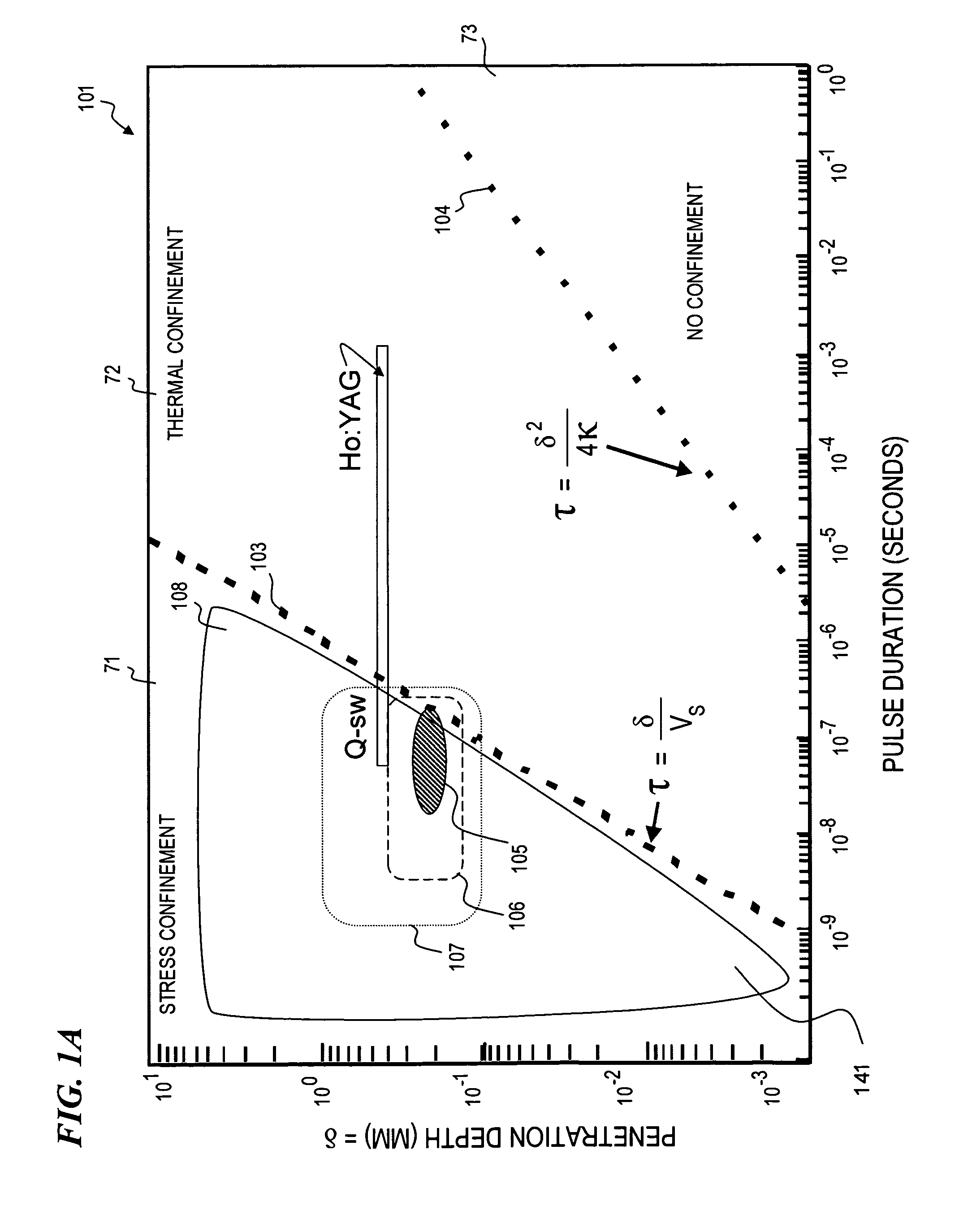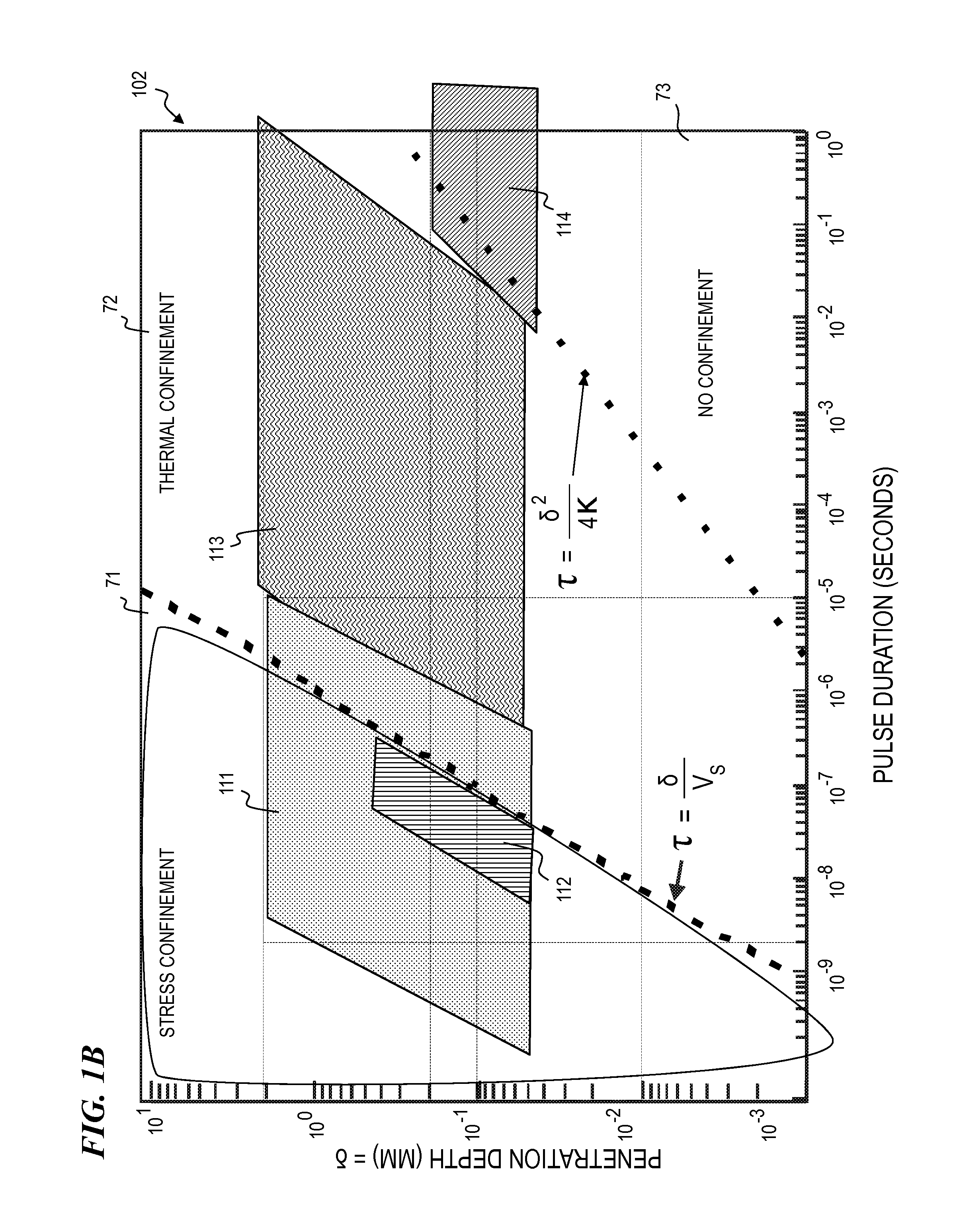[0045]In some embodiments, the present invention provides an apparatus and process having a plurality of
modes of operation at least some of which share a
fiber laser and / or
fiber amplifier that is used to provide laser power for the plurality of
modes of operation, including a
cutting mode (e.g., by forming an overlapping, contiguous, or near contiguous series of micropores along a line to be
cut), a cauterizing mode, a fractional photolysis mode and / or the like. In some embodiments, the apparatus is battery-powered, portable, and lightweight enough to be easily carried by a physician during use (e.g., having a computer-battery-laser portion that can be hung from a belt around the physicians
waist, placed in a
vest pocket, strapped to the physician's arm, or the like, and a light-delivery portion that can, for example, be held in the hand like a scalpel or pen). In some embodiments, a small rechargeable and / or replaceable battery of a type similar to that used in
laptop computers is packaged together with the other heavy and / or bulky portions (e.g.,
semiconductor lasers used to obtain pump light, optically pumped
fiber laser(s) and / or
amplifier(s) used to receive the pump light and to generate and / or amplify the therapeutic
laser light wavelength (also called the
signal wavelength), electronic power supplies and conditioners to supply electrical power to the
semiconductor pump lasers, controller and safety circuits used to control the types and timing of the
signal-laser output for the various
modes of operation), which are then connected via
optical fiber to the handpiece used by the surgeon to perform the cutting, cauterizing, or other therapeutic operations. In some embodiments, the therapeutic
laser light is of an
infrared wavelength (e.g., between 1.9 and 2 micron wavelength), so visible light is also generated and delivered by optical fiber to the site of the operation to indicate the mode of operation and / or indicate the location to which the therapeutic
laser light will be delivered (i.e., emitting a
visible laser beam of a first color (or quality (such as pulsating in intensity)) to indicate that the therapeutic laser light is “off” and that when the therapeutic laser light is turned on, where the cutting / cauterizing will occur, and emitting a
visible laser beam of a second color (or quality (such as outputting
constant intensity)) to indicate that the therapeutic laser light is “on” and that the cutting / cauterizing is occurring.
[0051]In some embodiments, the present invention provides an apparatus and process wherein a high-power, pulsed
thulium laser outputs
infrared laser pulses delivered through an optical fiber, for cutting and ablating
biological tissue. In some embodiments, the
pulse duration is shortened sufficiently to keep inside the stress-confined ablation region of operation. In some embodiments, the pulse is shortened to near the stress-confined ablation region of operation, while, in some embodiments, being slightly in the thermal-constrained region of operation (in order to obtain a controlled-thickness wall of
thermal coagulation or
cauterization, e.g., in some such embodiments, the wall thickness of this thermal zone is between about 50 microns and 200 microns). In some embodiments, the laser is coupled to a small low-OH optical fiber (˜100 μm
diameter). In some embodiments, the device has a
pulse duration of about 100 ns for efficient ablation; however, in some embodiments this parameter is adjustable. In some embodiments, the pulse length is adjustable to a first mode of operation in or near the stress-confined region of operation to
cut or remove tissue with little or no collateral heat damage to surrounding tissue, and / or to a second mode of operation in or near the thermal-confined region of operation to coagulate blood to stop or prevent bleeding in surrounding tissue and / or to kill tissue surrounding the irradiated zone without (or while minimizing) the risk of surrounding tissue becoming dislodged (e.g., to prevent possible spread of cancerous cells to other parts of the body). In some embodiments, the pulse repetition rate (PRR) is adjustable from one or more single pulses to 50-kHz repeated pulses (in some embodiments, the PRR is variable up to 100 KHz). In some embodiments, the laser has a tunable
pulse energy output (i.e., non-zero pulses) up to 50 mJ as output from the delivery fiber.
[0055]Other advantages with the
thulium fiber laser besides more efficient ablation include a smaller size and greater power efficiency than the current technologies. In some embodiments, the present invention provides a battery-powered surgical / coagulation device that is readily portable and
usable in harsh environments such as on a
battlefield. In some embodiments, the present invention provides a battery-powered multiple-mode surgical cutting and / or coagulation device that is readily portable and
usable in harsh environments such as on a
battlefield.
 Login to View More
Login to View More  Login to View More
Login to View More 


